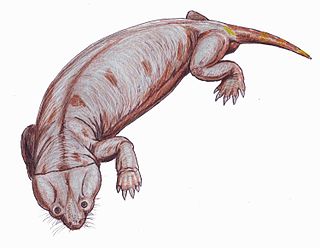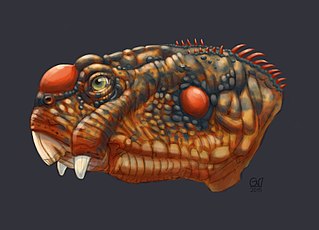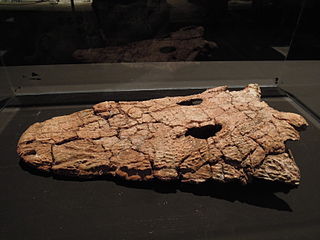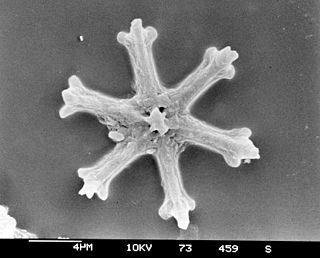Related Research Articles

Palynology is the study of microorganisms and microscopic fragments of mega-organisms that are composed of acid-resistant organic material and occur in sediments, sedimentary rocks, and even some metasedimentary rocks. Palynomorphs are the microscopic, acid-resistant organic remains and debris produced by a wide variety plants, animals, and Protista that have existed since the late Proterozoic.

Biostratigraphy is the branch of stratigraphy which focuses on correlating and assigning relative ages of rock strata by using the fossil assemblages contained within them. The primary objective of biostratigraphy is correlation, demonstrating that a particular horizon in one geological section represents the same period of time as another horizon at a different section. Fossils within these strata are useful because sediments of the same age can look completely different, due to local variations in the sedimentary environment. For example, one section might have been made up of clays and marls, while another has more chalky limestones. However, if the fossil species recorded are similar, the two sediments are likely to have been laid down around the same time. Ideally these fossils are used to help identify biozones, as they make up the basic biostratigraphy units, and define geological time periods based upon the fossil species found within each section.
A stratigraphic unit is a volume of rock of identifiable origin and relative age range that is defined by the distinctive and dominant, easily mapped and recognizable petrographic, lithologic or paleontologic features (facies) that characterize it.

In biostratigraphy, biostratigraphic units or biozones are intervals of geological strata that are defined on the basis of their characteristic fossil taxa, as opposed to a lithostratigraphic unit which is defined by the lithological properties of the surrounding rock.

The Cistecephalus Assemblage Zone is a tetrapod assemblage zone or biozone found in the Adelaide Subgroup of the Beaufort Group, a majorly fossiliferous and geologically important geological group of the Karoo Supergroup in South Africa. This biozone has outcrops located in the Teekloof Formation north-west of Beaufort West in the Western Cape, in the upper Middleton and lower Balfour Formations respectively from Colesberg of the Northern Cape to east of Graaff-Reinet in the Eastern Cape. The Cistecephalus Assemblage Zone is one of eight biozones found in the Beaufort Group, and is considered to be Late Permian in age.

The Daptocephalus Assemblage Zone is a tetrapod assemblage zone or biozone found in the Adelaide Subgroup of the Beaufort Group, a majorly fossiliferous and geologically important geological Group of the Karoo Supergroup in South Africa. This biozone has outcrops located in the upper Teekloof Formation west of 24°E, the majority of the Balfour Formation east of 24°E, and the Normandien Formation in the north. It has numerous localities which are spread out from Colesberg in the Northern Cape, Graaff-Reniet to Mthatha in the Eastern Cape, and from Bloemfontein to Harrismith in the Free State. The Daptocephalus Assemblage Zone is one of eight biozones found in the Beaufort Group and is considered Late Permian (Lopingian) in age. Its contact with the overlying Lystrosaurus Assemblage Zone marks the Permian-Triassic boundary.

The Cynognathus Assemblage Zone is a tetrapod biozone utilized in the Karoo Basin of South Africa. It is equivalent to the Burgersdorp Formation, the youngest lithostratigraphic formation in the Beaufort Group, which is part of the fossiliferous and geologically important Karoo Supergroup. The Cynognathus Assemblage Zone is the youngest of the eight biozones found in the Beaufort Group, and is considered to be late Early Triassic (Olenekian) to early Middle Triassic (Anisian) in age. The name of the biozone refers to Cynognathus crateronotus, a large and carnivorous cynodont therapsid which occurs throughout the entire biozone.

The Tropidostoma Assemblage Zone is a tetrapod assemblage zone or biozone which correlates to the lower Teekloof Formation, Adelaide Subgroup of the Beaufort Group, a fossiliferous and geologically important geological Group of the Karoo Supergroup in South Africa. The thickest outcrops, reaching approximately 240 metres (790 ft), occur from east of Sutherland through to Beaufort West and Victoria West, to areas south of Graaff-Reinet. Its northernmost exposures occur west/north-west of Colesberg. The Tropidostoma Assemblage Zone is the fourth biozone of the Beaufort Group.
Argonauta tokunagai is an extinct species of octopus. It was described in 1913 based on fossil material from the Middle Miocene Huzina Formation of Japan.

Turritellidae, with the common name "tower shells" or "tower snails", is a taxonomic family of small- to medium-sized sea snails, marine gastropod molluscs in the Sorbeoconcha clade.

Eryosuchus is an extinct genus of capitosauroid temnospondyl amphibian from the Middle Triassic of northern Russia. It was a very large predator: the largest specimen known could reach up to 3.5 m (11.5 ft) in length, with a skull over 1 m long.
In biostratigraphy, a local-range zone, topozone or teilzone is the stratigraphic range of the rock unit between the first and last appearance datum of a particular taxon in a local area. It is a subset of the global biozone for that taxon. For the teilzone data to be meaningful, the local area must be identified. The term was coined in 1914 by German paleontologist and geologist Josef Felix Pompeckj.

Platycraniellus is an extinct genus of carnivorous cynodonts from the Early Triassic. It is known from the Lystrosaurus Assemblage Zone of the Normandien Formation in South Africa. P. elegans is the only species in this genus based on the holotype specimen from the Ditsong National Museum of Natural History in Pretoria, South Africa. Due to limited fossil records for study, Platycraniellus has only been briefly described a handful of times.
The Höganäs Formation is a Late Triassic to Early Jurassic geologic formation in Skåne, Sweden. The formation is mostly known for its incredible flora collection from the Bjuv member, composed of over 110 species, and also includes several vertebrate remains, such as fishes, amphibians and dinosaur tracks & remains, although none have yet been referred to a specific genus.
HD 133600, also known as HIP 73815, is a G-type star in the constellation of Virgo. It has an apparent visual magnitude of approximately 8.219m. It is similar to the Sun and has been called a near solar twin, as it is 1.5 billion years older than the Sun.

The San Quintín Volcanic Field is a collection of ten or eleven volcanic cinder cones situated along the Pacific coast of the Baja California peninsula in Mexico. The field formed by repeated eruptions beginning in the Pleistocene and ending about 3000 years ago. It is one of several known Quaternary period volcanic fields in Baja. The lava shields appear to have first grown as subaqueous volcanoes that emerged as islands.
Diplognathodus is an extinct genus of conodonts in the family Anchignathodontidae. Specimens are found in Carboniferous and Permian formations.

The Balfour Formation is a geological formation that is found in the Beaufort Group, a major geological group that forms part of the greater Karoo Supergroup in South Africa. The Balfour Formation is the uppermost formation of the Adelaide Subgroup which contains all the Late Permian-aged biozones of the Beaufort Group. Outcrops and exposures of the Balfour Formation are found from east of 24 degrees in the highest mountainous escarpments between Beaufort West and Fraserburg, but most notably in the Winterberg and Sneeuberg mountain ranges near Cradock, the Baviaanskloof river valley, Graaff-Reniet and Nieu Bethesda in the Eastern Cape, and in the southern Free State province.

The Rotzo Formation is a geological formation in Italy, dating to roughly between 189 and 183 million years ago and covering the Pliensbachian stage of the Jurassic Period in the Mesozoic Era. Has been traditionally classified as a Sinemurian-Pliensbachian Formation, but a large and detailed dataset of isotopic 13C and 87Sr/86Sr data, estimated the Rotzo Formation to span only over the whole Pliensbachian. The Rotzo Formation represented the Carbonate Platform, being located over the Trento Platform and surrounded by the Massone Oolite, the Fanes Piccola Encrinite, the Lombadian Basin Medolo Group and Belluno Basin Soverzene Formation, and finally towards the south, deep water deposits of the Adriatic Basin. The also Pliensbachian Aganane Formation of Morocco represents a regional equivalent, both in deposition and faunal content.

Calcareous nannofossils are a class of tiny microfossils that are similar to coccoliths deposited by the modern-day coccolithophores. The nannofossils are a convenient source of geochronological data due to the abundance and rapid evolution of the single-cell organisms forming them (nannoplankton) and ease of handling of the sediment samples. The practical applications of calcareous nannofossils in the areas of biostratigraphy and paleoecology became clear once the deepwater drilling took off in 1968 with the Deep Sea Drilling Project, and they have been extensively studied ever since. Nannofossils provide one of the most important paleontological records with the contiguous length of 220 million years.
References
- ↑ Holtz, Thomas R. Jr; Merck, John W. Jr. (2006). "GEOL 331 Lectures 6-7: Biostratigraphy". GEOL 331: Principles of Paleontology. University of Maryland. Archived from the original on 2007-06-20. Retrieved 2008-04-16.